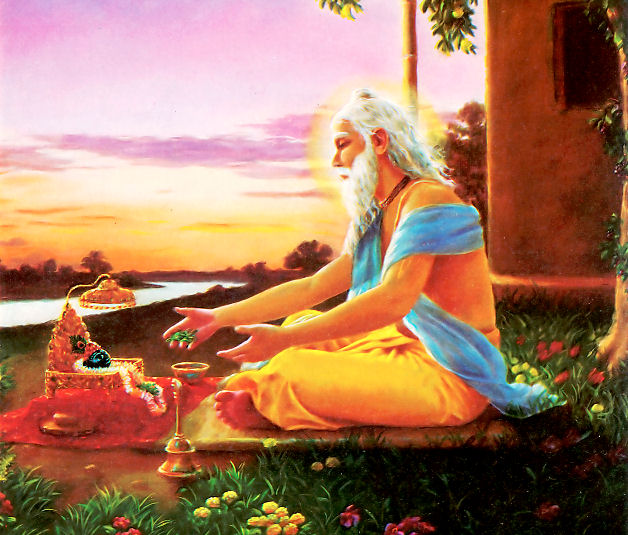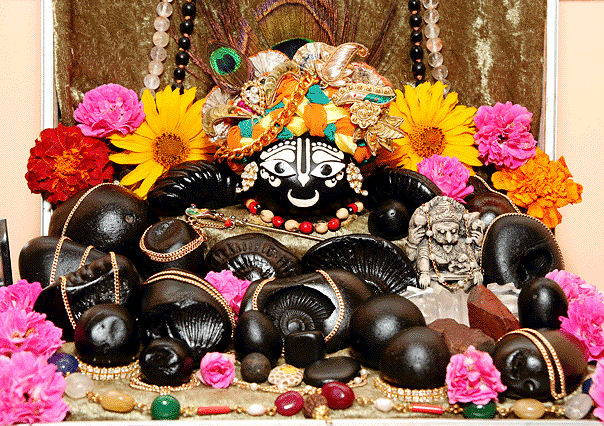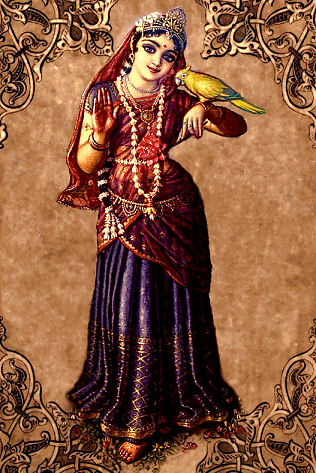- Śrīmatī Vṛndā Devī - - Śrīmatī Tulasī Devī -
Another name of Tulasī is Vṛndā-devī (one who awards residence in Vṛndāvana). Vṛndā-devī is a pure devotee of Lord
Kṛṣṇa and an expansion of Śrīmatī Rādhārāṇī. She is responsible for setting up the wonderful pastimes of Śrī Rādhā and
Kṛṣṇa in Vṛndāvana. She exists as Tulasī to benefit the fallen conditioned souls by bestowing devotional service to Kṛṣṇa.
Tulasī Stotras
| Tulasī Aṣṭa-nāma-stava Tulasī Aṣṭottara Śatanāmāvalī Śrī Vṛndādevy-aṣṭakam |
Śrī-Tulasī-Stava Śrī-Tulasī-stotram |
Aṣṭa-nāma-stava from the Padma Purāṇa
The Eight Names of Vṛndā-devī
Vṛndā Devī, Vṛndāvanī, Viśvapūjitā, Viśvapāvanī,
Puṣpasāra, Nandinī, Tulasī Devī, Kṛṣṇa-jīvanī
- Vṛndā Devī - She has thousand and thousands of sakhīs (associate maidservants).
- Vṛndāvanī - She never leaves Vṛndāvana.
- Viśvapūjitā - The whole universe worships her.
- Viśvapāvanī - She is the sanctifier of the whole world.
- Puṣpasāra - She is the essence of all flowers.
- Nandinī - She gives happiness to everyone.
- Tulasī Devī - She has an incomparable form.
- Kṛṣṇa-jīvanī - She is the life and soul of Lord Kṛṣṇa.
Anyone while worshiping Tulasī-devī chants these eight names will get the same results as one who performs the Aśvamedha sacrifice. And one who on the full-moon day of Kartika (Tulasī-devī's appearance day) worships Her with this Mantra will break free from the bonds of this miserable world of birth and death, and very quickly attains Goloka-Vṛndāvan. On the full moon-day of Kartik Lord Śrī Kṛṣṇa Himself worships Śrīmati Tulasī-devī with this Mantra.
"One who remembers this Mantra will very quickly
attain
devotion to Lord Kṛṣṇa's Transcendental Lotus Feet."
---------------

CC Adi 3
Advaita Ācārya was a contemporary of Lord Caitanya's father. He felt sorry for the condition of the world because even after Lord Kṛṣṇa's appearance, no one had interest in devotional service to Kṛṣṇa. This forgetfulness was so overwhelming that Advaita Prabhu was convinced that no one but Lord Kṛṣṇa Himself could enlighten people about devotional service to the Supreme Lord. Therefore Advaita requested Lord Kṛṣṇa to appear as Lord Caitanya. OFFERING TULASĪ LEAVES AND GANGES WATER, HE CRIED FOR THE LORD'S APPEARANCE. THE LORD, BEING SATISFIED BY HIS PURE DEVOTEES, DESCENDS TO SATISFY THEM. As such, being pleased by Advaita Ācārya, Lord Caitanya appeared.

Worshipping the Śālagrāma-Śilā with Tulasī-leaves
ei śilāre kara tumi sāttvika pūjana / acirāt pābe tumi kṛṣṇa-prema-dhana
eka kuṅjā jala āra tulasī-mañjarī /
sāttvika-sevā ei-śuddha-bhāve kari
dui-dike dui-patra madhye komala mañjarī /
ei-mata aṣṭa-mañjarī dibe śraddhā kari
śrī-haste śilā diyā ei ājñā dilā /
ānande raghunātha sevā karite lāgilā
(CC Antya 6.295-98)
"Śrī Caitanya Mahāprabhu continued, "Worship this Śilā stone in the mode of goodness like a perfect brāhmaṇa, for by such worship you will surely attain ecstatic love of Kṛṣṇa without delay.
"For such worship, one needs a jug of water and a few flowers from a tulasī tree. This is worship in complete goodness when performed in complete purity.
"With faith and love, you should offer eight soft tulasī flowers, each with two tulasī leaves, one on each side of each flower."
"After thus advising him how to worship, Lord Śrī Caitanya Mahāprabhu personally offered Raghunātha dāsa the govardhana-śilā with His transcendental hand. As advised by the Lord, Raghunātha dāsa worshiped the śilā in great transcendental jubilation."
- SB 7.14.29 P Ideal Family Life
Therefore, in the temple there must be the Deity of the Lord, and the Lord should be worshiped by the devotees. This combination of the devotees and the Deity creates a first-class transcendental place. Aside from this, if a gṛhastha devotee worships the śālagrāma-śilā, or the form of the Deity at home, his home also becomes a very great place. It was therefore customary for members of the three higher classes—namely the brāhmaṇas, kṣatriyas and vaiśyas—to worship the śālagrāma-śilā, or a small Deity of Rādhā-Kṛṣṇa or Sītā-Rāma in each and every home. This made everything auspicious.
- Adi 13.86 p. The Advent of Lord Sri Caitanya Mahaprabhu
TRANSLATION: After this conversation, both husband and wife were very jubilant, and together they rendered service to the household śālagrāma-śilā.
PURPORT: Especially in every brāhmaṇa's house there must be a śālagrāma-śilā to be worshiped by the brāhmaṇa family. This system is still current. People who are brāhmaṇa by caste, who are born in a brāhmaṇa family, must worship the śālagrāma-śilā. Unfortunately, with the progress of Kali-yuga, the so-called brāhmaṇas, although very proud of taking birth in brāhmaṇa families, no longer worship the śālagrāma-śilā. But actually it has been a custom since time immemorial that a person born in a brāhmaṇa family must worship the śālagrāma-śilā in all circumstances. In our Kṛṣṇa consciousness society, some of the members are very anxious to introduce the śālagrāma-śilā, but we have purposely refrained from introducing it because most of the members of the Kṛṣṇa consciousness movement do not originally come from families of the brāhmaṇa caste. After some time, when we find that they are actually situated strictly in the line of brahminical behavior, this śālagrāma-śilā will be introduced.
In this age, the worship of the śālagrāma-śilā is not as important as the chanting of the holy name of the Lord. That is the injunction of the śāstra. Harer nāma harer nāma harer nāmaiva kevalam kalau nāsty eva nāsty eva nāsty eva gatir anyathā. Śrīla Jīva Gosvāmī's opinion is that by chanting the holy name offenselessly one becomes completely perfect. Nevertheless, just to purify the situation of the mind, worship of the Deity in the temple is also necessary. Therefore when one is advanced in spiritual consciousness or is perfectly situated on a spiritual platform he may take to the worship of the śālagrāma-śilā.
- Adi 7.45 Lord Caitanya in Five Features
..... they are bona fide spiritual masters who have the facility to worship the śālagrāma-śilā, which is worshiped with the Deity. As of this writing, śālagrāma-śilā worship has not yet been introduced in our Kṛṣṇa consciousness movement, but soon it will be introduced in all our temples as an essential function of arcana-mārga (Deity worship).
Shalagrama-Shila-by-Padmanabha-Goswami.pdf
« NEXT »


